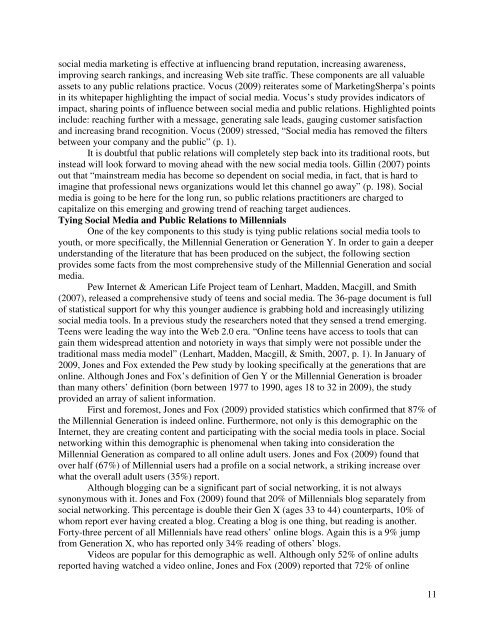2010 - Public Relations Society of America
2010 - Public Relations Society of America
2010 - Public Relations Society of America
Create successful ePaper yourself
Turn your PDF publications into a flip-book with our unique Google optimized e-Paper software.
social media marketing is effective at influencing brand reputation, increasing awareness,<br />
improving search rankings, and increasing Web site traffic. These components are all valuable<br />
assets to any public relations practice. Vocus (2009) reiterates some <strong>of</strong> MarketingSherpa’s points<br />
in its whitepaper highlighting the impact <strong>of</strong> social media. Vocus’s study provides indicators <strong>of</strong><br />
impact, sharing points <strong>of</strong> influence between social media and public relations. Highlighted points<br />
include: reaching further with a message, generating sale leads, gauging customer satisfaction<br />
and increasing brand recognition. Vocus (2009) stressed, “Social media has removed the filters<br />
between your company and the public” (p. 1).<br />
It is doubtful that public relations will completely step back into its traditional roots, but<br />
instead will look forward to moving ahead with the new social media tools. Gillin (2007) points<br />
out that “mainstream media has become so dependent on social media, in fact, that is hard to<br />
imagine that pr<strong>of</strong>essional news organizations would let this channel go away” (p. 198). Social<br />
media is going to be here for the long run, so public relations practitioners are charged to<br />
capitalize on this emerging and growing trend <strong>of</strong> reaching target audiences.<br />
Tying Social Media and <strong>Public</strong> <strong>Relations</strong> to Millennials<br />
One <strong>of</strong> the key components to this study is tying public relations social media tools to<br />
youth, or more specifically, the Millennial Generation or Generation Y. In order to gain a deeper<br />
understanding <strong>of</strong> the literature that has been produced on the subject, the following section<br />
provides some facts from the most comprehensive study <strong>of</strong> the Millennial Generation and social<br />
media.<br />
Pew Internet & <strong>America</strong>n Life Project team <strong>of</strong> Lenhart, Madden, Macgill, and Smith<br />
(2007), released a comprehensive study <strong>of</strong> teens and social media. The 36-page document is full<br />
<strong>of</strong> statistical support for why this younger audience is grabbing hold and increasingly utilizing<br />
social media tools. In a previous study the researchers noted that they sensed a trend emerging.<br />
Teens were leading the way into the Web 2.0 era. “Online teens have access to tools that can<br />
gain them widespread attention and notoriety in ways that simply were not possible under the<br />
traditional mass media model” (Lenhart, Madden, Macgill, & Smith, 2007, p. 1). In January <strong>of</strong><br />
2009, Jones and Fox extended the Pew study by looking specifically at the generations that are<br />
online. Although Jones and Fox’s definition <strong>of</strong> Gen Y or the Millennial Generation is broader<br />
than many others’ definition (born between 1977 to 1990, ages 18 to 32 in 2009), the study<br />
provided an array <strong>of</strong> salient information.<br />
First and foremost, Jones and Fox (2009) provided statistics which confirmed that 87% <strong>of</strong><br />
the Millennial Generation is indeed online. Furthermore, not only is this demographic on the<br />
Internet, they are creating content and participating with the social media tools in place. Social<br />
networking within this demographic is phenomenal when taking into consideration the<br />
Millennial Generation as compared to all online adult users. Jones and Fox (2009) found that<br />
over half (67%) <strong>of</strong> Millennial users had a pr<strong>of</strong>ile on a social network, a striking increase over<br />
what the overall adult users (35%) report.<br />
Although blogging can be a significant part <strong>of</strong> social networking, it is not always<br />
synonymous with it. Jones and Fox (2009) found that 20% <strong>of</strong> Millennials blog separately from<br />
social networking. This percentage is double their Gen X (ages 33 to 44) counterparts, 10% <strong>of</strong><br />
whom report ever having created a blog. Creating a blog is one thing, but reading is another.<br />
Forty-three percent <strong>of</strong> all Millennials have read others’ online blogs. Again this is a 9% jump<br />
from Generation X, who has reported only 34% reading <strong>of</strong> others’ blogs.<br />
Videos are popular for this demographic as well. Although only 52% <strong>of</strong> online adults<br />
reported having watched a video online, Jones and Fox (2009) reported that 72% <strong>of</strong> online<br />
11
















